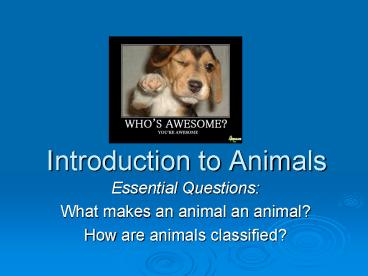Introduction to Animals PowerPoint PPT Presentation
1 / 19
Title: Introduction to Animals
1
Introduction to Animals
- Essential Questions
- What makes an animal an animal?
- How are animals classified?
2
Kingdom Animalia
- Eukaryotic
- Heterotrophic
- Multicellular
- Tissues and organs formed by specialized cells
- No cell walls
- Likely evolved from animal-like protists
3
Essential Functions
- All animals carry out the following
- Obtain food from the environment
- Exchange O2 CO2 through skin, gills, lungs, etc
- Move materials around body
- Get rid of wastes
- Process information with nerves
- All animals are motile at some point
- Most reproduce sexually, some asexually
4
Reproduction Development
- Animals mainly reproduce sexually
- Fertilization sperm meets egg, either within or
outside the body - External fertilization (in water)
- Internal fertilization (on land)
- What are the positives
- and negatives of each
- type of fertilization?
5
(No Transcript)
6
Reproduction Development
- Steps of Development
- Fertilization results in a unicellular zygote
- The unicellular zygote divides by mitosis
cleavage - A hollow ball of cells (blastula) forms
- Gastrulation (folding inward) forms 2 cells
layers ectoderm and endoderm - Mesoderm forms
7
Coelomate vs Acoelomates
- Coelom fluid filled cavity that supports
internal organs. - Acoelomates no internal cavity. Example
Flatworms - Pseudocoelomates body cavity develops between
endoderm and mesoderm. Example Roundworms - Coelomates internal organs suspended in a body
cavity surrounded by mesoderm. Example
Earthworms
Why the Coelom? The coelom is significant because
as animals evolved, so did the presence of a
complex body cavity to support more complex
organs!
8
Symmetry
- Animals can be described in terms of their
symmetry - Asymmetry irregular in shape Example Sponge
- Radial Symmetry can be divided through along
any plane into halves from the mouth. Example
Anemone - Bilateral Symmetry can be divided lengthwise
into 2 mirror images. Example Humans - Cephalization concentration of sense organs at
the front (top) of the body
9
Body Positioning
- Bisymmetrical animals have 4 parts
- Anterior the head end, where sensory organs are
located - Posterior the tail end (anus)
- Dorsal Back surface where the spine is located
- Ventral The belly side
10
Framework for support Skeletons
- Exoskeletons hard, waxy covering on the
exterior of the body. - Prevent water loss, protect soft tissues
- Endoskeletons internal skeleton for support
made of Calcium Carbonate, cartilage or bone - Protects internal organs and an internal brace
for muscles to pull against
To survive on land, why is it important to have a
strong skeleton?
11
Framework for support Skeletons
- Invertebrates an animal without a backbone
usually has exoskeleton - Echinoderms have endoskeletons
- Vertebrates an animal with a backbone
bilaterally symmetry exoskeleton
12
Invertebrates
- Make up 95 of all animals
- No backbone, or vertebral column. Most have
exoskeletons. - Open circulatory systems (with a one chambered
heart) - Cannot process Oxygen very well, restricts their
size and survival on land.
13
Invertebrate Phyla
- Phylum Porifera - Sponges
- Phylum Cnidaria Corals, Hydra Jellyfish
- Phylum Platyhelminthes - Flatworms
- Phylum Nematoda Roundworms
- Phylum Mollusca Snails, squid Clams
- Phylum Annelida - Segmented Worms
- Phylum Arthropoda Insects, spiders, lobsters
- Phylum Enchinodermata Starfish
- Invertebrate members of Phylum Chordata Sea
squirts, Lancelets
14
Phylum Annelida
- The segmented worms. Example earthworms,
leeches - Segmentation allows movement of individual parts
- Possess a true coelom
- Specialized organs and systems
15
Phylum Chordata Subphylum Vertebrata
- Class Agnatha (jawless fishes)
- Class Chondrichthyes (cartilaginous fishes)
- Class Osteichthyes (bony fishes)
- Class Amphibia (amphibians)
- Class Reptilia (reptiles)
- Class Aves (birds)
- Class Mammalia (mammals)
16
Vertebrates
- 5 of all animals
- Have a vertebral column.
- The backbone gives support to the body and
protection to the spinal cord - Have endoskeletons.
- Closed circulatory system with a multichambered
heart - Classification Kingdom Animalia, Phylum
Chordata, Subphylum - Vertebrata
17
Types of Mammals
- Subclasses based on type of reproduction
- Placental (95) young fully develops in uterus
before birth - Marsupials short period of development inside
the mother followed by a second period of
development inside pouch - Monotremes - lay eggs. species platypus and 2
echidnas
18
Vertebrates Am I hot or not?
- The major difference between vertebrates is
whether or not they can regulate their own body
temperature. - Ectotherms regulated by environment
- Example fish, frogs, snakes
- Endotherms regulated by their own body
- Example mammals
19
- Animals that are ectothermic (like snakes) dont
require food as much as endotherms. - What does this indicate about the
relationship between food requirements and the
generation of body heat? - How does this fact restrict where certain
types of animals can live? - If the environment were to suddenly get cold
(like an ice age), which of the animals could
survive?

